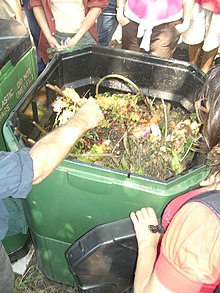Green waste
| Part of aserieson |
| Pollution |
|---|
 |
Green waste,also known as "biological waste",is anyorganicwaste that can becomposted.It is most usually composed of refuse from gardens such as grass clippings or leaves, and domestic or industrial kitchen wastes. Green waste does not include things such as dried leaves, pine straw, or hay. Such materials are rich incarbonand considered "brown wastes,"while green wastes contain high concentrations ofnitrogen.Green waste can be used to increase the efficiency of many composting operations and can be added to soil to sustain localnutrient cycling.
Collection of green waste[edit]
Green waste can be collected viamunicipalcurbside collectionschemes or through privatewaste managementbusinesses. Many communities, especially in the United Kingdom, have initiated green wasterecycling and collection programsin order to decrease the amount ofbiodegradable materials in landfills.[1]Communities are provided with, or can provide their own, compost receptacles that they fill with plant and food remains, which are then emptied on a regular basis. Programs such as this allow communities to be an active part of composting their green waste which allows them to play an active role in decreasing the amount of food being dumped into local[2]andregional landfills.[1]
A variety of apps are now available to guide individuals and businesses in recycling efforts. These apps can help locate recycling centers, inform about recyclable materials in local areas, and facilitate the donation or exchange of unwanted items.[3]
Pello System[edit]
A technology that monitors the fill level of trash cans, provides real-time information on the dumpsters' contents and location, identifies contamination, and sends pickup alerts. This system aims to streamline waste management and reduce unnecessary garbage truck dispatches, thereby lowering greenhouse gas emissions and traffic congestion.[3]
Pneumatic Waste Pipes[edit]
Installed below public waste containers, these pipes transport waste directly to processing centers, reducing the need for traditional trash pickup. This system decreases the number of garbage trucks on roads, minimizing emissions and potential environmental health hazards from overflowing dumpsters.[3]

Uses[edit]
Green waste can be used to improve the quality and sustainability of industriallymanufactured topsoilsand the sanitariness and efficiency ofsewage disposal.[4][5]Green wastes likeagricultural wastescan also be converted to human edible foods by makingleaf protein concentrate.[6]
Manufactured topsoils[edit]
Green waste is an integral part of manymanufactured topsoils,as it provides both nutrients for growing plants and increases the volume of manufactured topsoils.[4]Its woody components do not decompose quickly, so they provide the bulk that is necessary for supplementary topsoils.[4]Mi xing industrial wastes such asfly ashorcoal dustwith green waste to create artificial topsoil not only facilitates therepurposingof industrial debris and keeps it out of landfills, but it also allows the nutrients in green waste materials to be cycled back into the environment. By utilizing fly ash in conjunction with green waste, manufactured soils are able to increase their water holding capacity while simultaneously recycling refuse materials that might otherwise take up space in a landfill.[4]This allows fly ash and green waste to increase local soil nutrient levels and promotes natural nutrient cycling processes.
Sewage disposal[edit]
Green waste can also be mixed withsewage wastesand composted, providing a safe, environmentally sustainable option for sewage disposal.[5]Co-composting green and sewage wastes eliminates the risk thatpathogensandpollutantscontained in sewage wastes might pose to the environment.[5]Utilization of green waste to dispose of sewage wastes not only decreases the amount of sewageincineratedand dumped each year, it also facilitates the cycling of organic wastes back into the environment. The co-composted remains of these organic wastes can be safely employed for use inagriculture.[5]This process decreases the amount of trash being dumped into landfills and other trash repositories and allows for the completecycling of organic nutrientsthrough the environment.
Renewable energy[edit]

Biogascaptured from biodegradable green waste can be used asbiofuel.Green waste can be composed ofnon-food crops,which decompose to producecellulosic ethanol.It can also help reduce the necessity of petroleum gases, which produce large amounts ofgreenhouse gases,such ascarbon dioxide,when burned.
Soil health[edit]
Green waste composting has also been linked to suppression of soil borne diseases such asdamping offandroot rotsthat affect large agricultural and horticultural ventures likegreenhousesandlarge-scale farms.[7]This disease suppressive quality has positive implications for lesser-developed nations that do not have the technology or resources to purchase expensivefertilizers.
Addition of composts that contain residues and particles ofheavy metalsto soil can raise the soil's heavy metal content and increase the probability of these metals to transfer into crop plants.[8]When biological, or green waste is added to these soil samples, plant uptake of heavy metal has been shown to decrease crop uptake of metals compared to other types of compost composed of things such as sewage sludge.[8]This can protect consumers and the environment frombiomagnificationcaused by long-termaccumulationof heavy metal particles within the soil and plant life of an area.[8]
See also[edit]
References[edit]
- ^abWilliams, I.D.; Kelly, J. (2003). "Green waste collection and the public's recycling behaviour in the Borough of Wyre, England".Resources, Conservation and Recycling.38(2): 139–159.doi:10.1016/s0921-3449(02)00106-4.ISSN0921-3449.
- ^"Green Gold Collection Day | The Samajh".The Samajh.8 March 2021. Archived fromthe originalon 5 June 2023.Retrieved2 December2021.
- ^abc"6 Smart Waste Management Technologies Emerging in 2024 | RTS".Recycle Track Systems.Retrieved2024-02-06.
- ^abcdBelyaeva, O.N.; Haynes, R.J. (2009). "Chemical, microbial and physical properties of manufactured soils produced by co-composting municipal green waste with coal fly ash".Bioresource Technology.100(21): 5203–5209.doi:10.1016/j.biortech.2009.05.032.ISSN0960-8524.PMID19539464.
- ^abcdJouraiphy, Abdelmajid; Amir, Soumia; El Gharous, Mohamed; Revel, Jean-Claude; Hafidi, Mohamed (2005). "Chemical and spectroscopic analysis of organic matter transformation during composting of sewage sludge and green plant waste".International Biodeterioration & Biodegradation.56(2): 101–108.doi:10.1016/j.ibiod.2005.06.002.ISSN0964-8305.
- ^Ugwoke, Blessing; Tieman, Ross; Mill, Aron; Denkenberger, David; Pearce, Joshua M. (2023)."Quantifying Alternative Food Potential of Agricultural Residue in Rural Communities of Sub-Saharan Africa".Biomass.3(2): 138–162.doi:10.3390/biomass3020010.ISSN2673-8783.
- ^Noble, R.; Coventry, E. (2005). "Suppression of soil-borne plant diseases with composts: A review".Biocontrol Science and Technology.15(1): 3–20.doi:10.1080/09583150400015904.ISSN0958-3157.S2CID85270472.
- ^abcSMITH, S (2009). "A critical review of the bioavailability and impacts of heavy metals in municipal solid waste composts compared to sewage sludge".Environment International.35(1): 142–156.doi:10.1016/j.envint.2008.06.009.ISSN0160-4120.PMID18691760.

